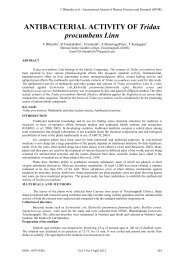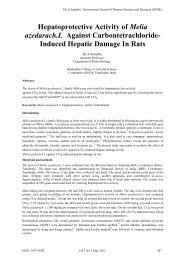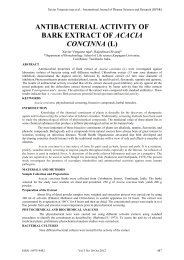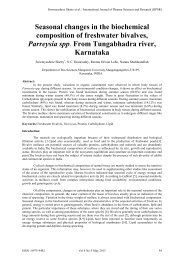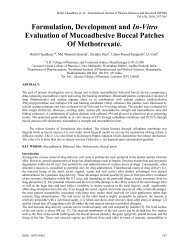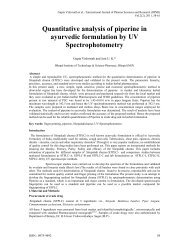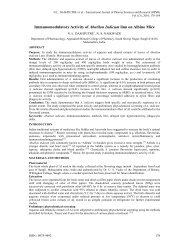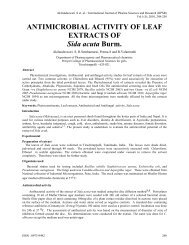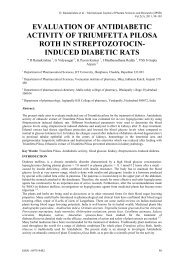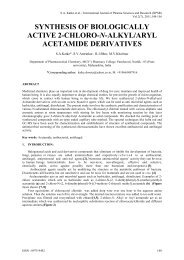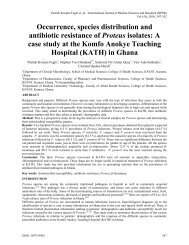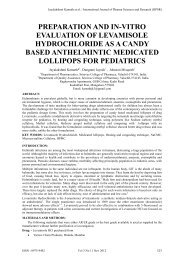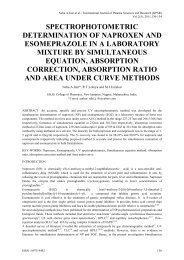Studies on some wild plant species used by the Mising (Miri) tribe of ...
Studies on some wild plant species used by the Mising (Miri) tribe of ...
Studies on some wild plant species used by the Mising (Miri) tribe of ...
Create successful ePaper yourself
Turn your PDF publications into a flip-book with our unique Google optimized e-Paper software.
N. K. Gam et al. / Internati<strong>on</strong>al Journal <strong>of</strong> Pharma Sciences and Research (IJPSR)<br />
<str<strong>on</strong>g>Studies</str<strong>on</strong>g> <strong>on</strong> <strong>some</strong> <strong>wild</strong> <strong>plant</strong> <strong>species</strong> <strong>used</strong> <strong>by</strong><br />
<strong>the</strong> <strong>Mising</strong> (<strong>Miri</strong>) <strong>tribe</strong> <strong>of</strong> Assam in <strong>the</strong>ir<br />
traditi<strong>on</strong>al food items.<br />
*N. K. Gam 1 , and J. Gam 2 .<br />
1 Department <strong>of</strong> Botany, Sibsagar College, Joysagar, Assam; India. 785665<br />
Email – gamnava@yahoo.co.in<br />
2 District Malaria Office, Baska, Assam, India 2<br />
gamjuagal@yahoo.co.in<br />
Abstract<br />
The <strong>Mising</strong> peoples are <strong>the</strong> sec<strong>on</strong>d largest plain <strong>tribe</strong>s <strong>of</strong> Assam inhabitati<strong>on</strong> in <strong>the</strong> Upper Assam particularly<br />
al<strong>on</strong>g <strong>the</strong> bank <strong>of</strong> river Brahmaputra. They are <strong>on</strong>e <strong>of</strong> <strong>the</strong> culturally rich ethnic <strong>tribe</strong> <strong>of</strong> Assam, mostly<br />
dependent <strong>on</strong> nature for <strong>the</strong>ir livelihood. They rear pigs and poultry in every house hold which is a part <strong>of</strong> <strong>the</strong>ir<br />
custom. Fishing in rivers and beels is ano<strong>the</strong>r important practice <strong>of</strong> <strong>the</strong>se people. Besides, <strong>the</strong>y use plenty <strong>of</strong><br />
<strong>wild</strong> <strong>plant</strong>s as vegetables in <strong>the</strong>ir daily food items from time immemorial. The paper deals with <strong>the</strong> investigati<strong>on</strong><br />
and documentati<strong>on</strong> <strong>of</strong> <strong>some</strong> important <strong>plant</strong> <strong>species</strong> habitually use in <strong>the</strong>ir food items particularly in n<strong>on</strong>vegetarian<br />
dishes. In this study, we also observed that <strong>the</strong> use <strong>of</strong> <strong>some</strong> <strong>of</strong> <strong>the</strong>se <strong>plant</strong> <strong>species</strong> is pertaining to <strong>the</strong>ir<br />
religious belief and festivals also.<br />
Key words: Wild <strong>plant</strong>s, <strong>Mising</strong>, Food habit, Traditi<strong>on</strong>al, Religious belief.<br />
Introducti<strong>on</strong><br />
The <strong>Mising</strong> (<strong>Miri</strong>) is an Indo-M<strong>on</strong>goloid and East Asian group <strong>of</strong> people migrated from <strong>the</strong> eastern<br />
Himalayan regi<strong>on</strong>s in Tibet in <strong>the</strong> hoary past and finally settled in <strong>the</strong> fertile Brahmaputra valley in Assam<br />
province <strong>of</strong> India. While migrating to Assam, <strong>the</strong> <strong>Mising</strong> followed mainly <strong>the</strong> course <strong>of</strong> <strong>the</strong> Brahmaputra,<br />
gradually spreading to o<strong>the</strong>r stretches <strong>of</strong> land lying <strong>on</strong> <strong>the</strong> banks <strong>of</strong> its tributaries like <strong>the</strong> Dihing, Disang,<br />
Dikhow, <strong>the</strong> Subansiri, <strong>the</strong> Ranganadi, <strong>the</strong> Dikr<strong>on</strong>g, etc. with habitati<strong>on</strong>s scattered now in eight districts <strong>of</strong> <strong>the</strong><br />
state, viz. Tinsukia, Dibrugarh, Dhemaji, Lakhimpur, Sibsager, Jorhat, Golaghat and S<strong>on</strong>itpur.<br />
Oh, friends, “The Dёrmi tender twig dance with breeze, <strong>the</strong> orchid flower give an immense beauty and<br />
pleasure to us” - <strong>the</strong> time immemorial folk s<strong>on</strong>g <strong>of</strong> <strong>Mising</strong> <strong>tribe</strong> definitely said that <strong>the</strong> cellular relati<strong>on</strong> <strong>of</strong> <strong>tribe</strong><br />
to <strong>the</strong> <strong>plant</strong> <strong>species</strong> in <strong>the</strong> multifold aspects. The Dёrmi <strong>plant</strong> was <strong>the</strong>ir first recognized <strong>wild</strong> greens cooked with<br />
fish and <strong>used</strong> as fodder for <strong>the</strong>ir pigs from where <strong>the</strong>y had <strong>the</strong>ir favorite pork. Kanjilal et al. (1992) reported <strong>the</strong><br />
same uses <strong>of</strong> <strong>the</strong> Dёrmi <strong>plant</strong> <strong>by</strong> <strong>the</strong> <strong>tribe</strong>.<br />
Methods<br />
The study was undertaken during 2010-2011 <strong>by</strong> c<strong>on</strong>ducting survey in eight district <strong>of</strong> upper Assam.<br />
The kitchen women, who regularly prepare <strong>the</strong> food items, <strong>the</strong> priest (Mibu) who suggested and directed <strong>the</strong><br />
necessary food items during traditi<strong>on</strong>al practices and festival, were interviewed. The preparati<strong>on</strong> <strong>of</strong> <strong>some</strong> foods<br />
item were observed, tasted and documented. . Ethnobotanical data were collect as suggested <strong>by</strong> Jain and Goel<br />
(1995). The ethnobotanical data were collected using questi<strong>on</strong>naire, interviews and discussi<strong>on</strong>s in <strong>the</strong>ir local<br />
dialect. Plant <strong>species</strong> were cross-examined with reference books (Kanjilal et al., 1992), photograph and<br />
identified <strong>by</strong> college and regi<strong>on</strong>al herbarium. The collected <strong>plant</strong> specimens were preserved according to <strong>the</strong><br />
c<strong>on</strong>venti<strong>on</strong>al herbarium techniques (Mitra, 1972). The collected and studied <strong>plant</strong> <strong>species</strong> were tabulated as N 1 ,<br />
N 2 …N n .<br />
ISSN : 0975-9492 Vol 3 No 12 Dec 2012 543
N. K. Gam et al. / Internati<strong>on</strong>al Journal <strong>of</strong> Pharma Sciences and Research (IJPSR)<br />
Result<br />
Number<br />
Table: 1- Plant <strong>species</strong> <strong>used</strong> <strong>by</strong> <strong>the</strong> <strong>Mising</strong> (<strong>Miri</strong>) <strong>tribe</strong> as vegetables.<br />
Botanical Name Family Vernacular Part(s)<br />
N 1 . Ficus spp. Moraceae Tajig/Taksek Tender leaves<br />
Usage/cooked<br />
with<br />
Mostly with pork,<br />
chicken<br />
N 2 .<br />
Sarchoclamis<br />
pulcherrima Goud.<br />
Urticaeae<br />
Ombe/<br />
Notke<br />
Tender leaves<br />
Mostly with pork<br />
N 3 . Sol<strong>on</strong>um indicum Lin. Solanaceae Bangko Fruits<br />
N 4 . Sol<strong>on</strong>um torvum Lin. Solanaceae Sita- bangko Fruits<br />
N 5 .<br />
N6.<br />
N 7 .<br />
N 8 .<br />
N 9 .<br />
Phlogacanthus<br />
curviflorus Nees.<br />
Clerodendr<strong>on</strong><br />
colebrookianum Walp.<br />
Antidesma<br />
Spreng.<br />
Meliosma<br />
Roxb.<br />
Meliosma<br />
Roxb.<br />
bunius<br />
pinnata<br />
simplifolia<br />
Roasted, fried with<br />
namsing, fried<br />
with potato.<br />
Roasted, fried with<br />
namsing, fried<br />
with potato.<br />
Acanthaceae K<strong>on</strong>ё-oying Tender leaves Meat, Fish<br />
Verbenaceae Pakkom Tender leaves<br />
Euphorbiaceae Somk<strong>on</strong>g-ύsing Fruits<br />
Roasted, fried with<br />
namsing, fried<br />
with potato.<br />
Fish and green<br />
vegetables<br />
Sabiaceae Dёrmi- ύsing Tender leaves Fish <strong>on</strong>ly<br />
Sabiaceae Gurban- ύsing Tender leaves Fish and pork<br />
N 10 . Dillenia indica Lin. Dilleniaceae Sompa Fruits (Calyx)<br />
N 11 . Musa sapientum, Lin. Musaceae Kopak Shoot<br />
N 12 .<br />
N 13 .<br />
N 14 .<br />
Buettneria<br />
colebr.<br />
aspera,<br />
Polyg<strong>on</strong>um assamicum<br />
Gandoger.<br />
Calamus<br />
tenuis/rotang/erecta.<br />
Sterculiaceae Risut-rύbύ Tender shoot Fish <strong>on</strong>ly<br />
Polyg<strong>on</strong>aceae Pinkёr/Nёkung Leaves Fish <strong>on</strong>ly<br />
Arecaceae<br />
Jeying/Jejing<br />
Tayo<br />
Tender shoot<br />
Mostly with fish<br />
and pork in<br />
general<br />
Chopped shoot<br />
fried with chicken<br />
<strong>on</strong>ly in <strong>the</strong> ritual<br />
practices.<br />
Roasted and mix<br />
with roasted<br />
namsing<br />
N 15 .<br />
Spilan<strong>the</strong>s<br />
Lin.<br />
acmella<br />
Asteraceae Marsang Tender leaves<br />
Roasted<br />
namsing<br />
with<br />
N 16 . Curcuma l<strong>on</strong>ga L. Zingiberaceae Alodi<br />
Rhizome,<br />
leaves<br />
Rhizome powder<br />
use as spice,<br />
leaves are use as<br />
wrapper for <strong>the</strong><br />
roasted <strong>of</strong> fish and<br />
meat.<br />
ISSN : 0975-9492 Vol 3 No 12 Dec 2012 544
N. K. Gam et al. / Internati<strong>on</strong>al Journal <strong>of</strong> Pharma Sciences and Research (IJPSR)<br />
N 17 . Eryngium foetida Lin. Umbeliferae Yumrang- O:ri<br />
Leaf and<br />
inflorescence<br />
N 18 . Polypodium spp.Lin. Polipodiaceae Bil<strong>on</strong>g<strong>on</strong>i Tender leaves<br />
N 19 .<br />
Phyrinium sp. Lin.<br />
Maranthaceae Kou-pat Leaves<br />
N 20 . Albizzia lucida Lin. Leguninaceae Tage- ύsing Tender leaves<br />
Leaf and<br />
inflorescence<br />
powder or paste<br />
<strong>used</strong> as spice.<br />
With chicken for<br />
enhance milk <strong>of</strong><br />
<strong>the</strong> newborn<br />
ba<strong>by</strong>’s mo<strong>the</strong>r<br />
Used as wrapper<br />
for <strong>the</strong> religious<br />
traditi<strong>on</strong>al food<br />
items.<br />
Cooked with fish<br />
and meat.<br />
Discussi<strong>on</strong><br />
The collected and documented <strong>plant</strong> <strong>species</strong> <strong>used</strong> <strong>by</strong> <strong>the</strong> community were listed in <strong>the</strong> table No. 1. The<br />
study investigated that <strong>the</strong>, N 1 , N 2 , N 8 and N 9 <strong>plant</strong> <strong>species</strong> were cooked <strong>on</strong>ly with pork in <strong>the</strong> Dodgang, Gyatiuyu,<br />
D<strong>on</strong>ύng, Dobur, and in <strong>the</strong> Ali: aye Lύgang <strong>the</strong> oldest agricultural festival celebrated in <strong>the</strong> m<strong>on</strong>th <strong>of</strong><br />
February every year. Such combinati<strong>on</strong> also found in <strong>the</strong> every household whenever <strong>the</strong>y cooked pork in <strong>the</strong>ir<br />
food item. It was found to that, <strong>the</strong> N 19 <strong>plant</strong> is <strong>used</strong> as wrapper for <strong>the</strong> preparati<strong>on</strong> <strong>of</strong> different pitha (Sweet- a<br />
community Specialty) in all festival and traditi<strong>on</strong>al ritual <strong>of</strong> <strong>the</strong> <strong>tribe</strong>. The N 4 leaf <strong>of</strong> <strong>plant</strong> is also use in <strong>the</strong><br />
preparati<strong>on</strong> <strong>of</strong> starter for traditi<strong>on</strong>al rice beer <strong>by</strong> <strong>the</strong> Deori <strong>tribe</strong> <strong>of</strong> Assam (Deori, C., et al., 2007). The N 11 <strong>plant</strong><br />
is reported as <strong>the</strong> medicine for diabetes (Borah, et al. 2009). N 17 <strong>plant</strong> <strong>species</strong> is use in disease against cough and<br />
br<strong>on</strong>chitis (Das and Rahman, 2011). The N 18 <strong>plant</strong> deserved <strong>the</strong> special menti<strong>on</strong>, as it is c<strong>on</strong>sume to enhance for<br />
<strong>the</strong> milk <strong>of</strong> newborn ba<strong>by</strong>’s mo<strong>the</strong>r. During investigati<strong>on</strong>, <strong>the</strong> milky extract from <strong>the</strong> bark <strong>of</strong> N 1 <strong>plant</strong> was found<br />
to be <strong>the</strong> treatment for <strong>the</strong> b<strong>on</strong>e fracture.<br />
N 2 N 13<br />
N 15<br />
N 2 N 6<br />
N 10 - cooked with pork<br />
ISSN : 0975-9492 Vol 3 No 12 Dec 2012 545
N. K. Gam et al. / Internati<strong>on</strong>al Journal <strong>of</strong> Pharma Sciences and Research (IJPSR)<br />
N 19 - prepared wrapped sweet<br />
N 19 - wrapping <strong>the</strong> rice for<br />
traditi<strong>on</strong>al food item.<br />
Discussi<strong>on</strong><br />
The <strong>Mising</strong> <strong>tribe</strong> kin to Adi <strong>tribe</strong> <strong>of</strong> Arunachal Pradesh, which bel<strong>on</strong>g to <strong>the</strong> Indo-M<strong>on</strong>goloid group,<br />
<strong>used</strong> huge numbers <strong>of</strong> <strong>wild</strong> <strong>plant</strong> <strong>species</strong> for various food items. Gajurel, P.R. (2006) reported that <strong>the</strong> Adi <strong>tribe</strong>s<br />
residing al<strong>on</strong>g <strong>the</strong> banks <strong>of</strong> Siang river towards South western Boundary <strong>of</strong> DDBR utilize about 150 <strong>wild</strong> <strong>plant</strong><br />
<strong>species</strong> for various purposes; <strong>of</strong> <strong>the</strong>se, about 85 <strong>plant</strong> <strong>species</strong> were found to be edible. Am<strong>on</strong>g <strong>the</strong>se, most <strong>of</strong> <strong>the</strong><br />
<strong>species</strong> were utilized as vegetables and fruits, while a few are <strong>used</strong> as medicine and for o<strong>the</strong>r needs. The present<br />
investigati<strong>on</strong> found 20 numbers <strong>of</strong> <strong>plant</strong> <strong>species</strong> habitually <strong>used</strong> <strong>by</strong> <strong>the</strong> <strong>Mising</strong> <strong>tribe</strong> <strong>of</strong> Assam as <strong>the</strong>se days;<br />
<strong>the</strong>y are fur flung from <strong>the</strong> rich <strong>plant</strong> <strong>species</strong> diversity. However, <strong>the</strong>ir <strong>plant</strong> vernacular names, similarity <strong>of</strong> food<br />
items to far extent indicated <strong>the</strong> closed relati<strong>on</strong>ship to <strong>the</strong> Adi <strong>tribe</strong> <strong>of</strong> Arunachal Pradesh and extensive <strong>used</strong> <strong>of</strong><br />
<strong>wild</strong> <strong>plant</strong> <strong>species</strong> for <strong>the</strong> various purpose before coming to <strong>the</strong> riverside areas <strong>of</strong> <strong>the</strong> Assam.<br />
The <strong>Mising</strong> <strong>tribe</strong> generally takes n<strong>on</strong>-vegetarian food items <strong>on</strong> <strong>the</strong>ir choice and taste. This is <strong>the</strong><br />
comm<strong>on</strong> feature <strong>of</strong> tribal peoples <strong>of</strong> earth in general. Pork and domestic fowl’s meat are <strong>the</strong> chief meat for <strong>the</strong>ir<br />
food items cooked with <strong>wild</strong> greens. They sacrifice <strong>the</strong> pig, hen and duck in <strong>the</strong>ir religious customs and ritual<br />
practices for <strong>the</strong> well-being <strong>of</strong> pers<strong>on</strong>, families and <strong>the</strong> society. The <strong>tribe</strong> <strong>used</strong> maximum number <strong>of</strong> <strong>wild</strong> greens<br />
in <strong>the</strong> cooked <strong>of</strong> pork meat than o<strong>the</strong>r meat. What domestic fowl to be scarify in what custom and ritual<br />
practices, were determine and fixed <strong>by</strong> <strong>the</strong> priest (Mibu), and <strong>the</strong>se practices transmitted generati<strong>on</strong> to<br />
generati<strong>on</strong>. To <strong>some</strong> extent, <strong>the</strong> <strong>wild</strong> greens are also fixe to cook with certain meat in certain traditi<strong>on</strong>al<br />
religious customs, ritual practices and festivals. Most <strong>of</strong> <strong>the</strong> rural peoples <strong>of</strong> <strong>Mising</strong> <strong>used</strong> more <strong>wild</strong> green<br />
vegetables than <strong>the</strong> cultivated. The urban peoples <strong>of</strong> <strong>Mising</strong> <strong>plant</strong>ed <strong>some</strong> such <strong>plant</strong>s in <strong>the</strong>ir kitchen garden,<br />
which are <strong>of</strong> a specific practice <strong>of</strong> l<strong>on</strong>g standing. Traditi<strong>on</strong>al habitual <strong>used</strong> and sumptuous nature is <strong>the</strong><br />
transmissi<strong>on</strong> customs or beliefs from generati<strong>on</strong> to generati<strong>on</strong> and such greens attract <strong>the</strong> c<strong>on</strong>servati<strong>on</strong> strategy<br />
<strong>of</strong> <strong>the</strong> <strong>plant</strong> <strong>species</strong>.<br />
C<strong>on</strong>clusi<strong>on</strong><br />
Present investigati<strong>on</strong> indicates that <strong>the</strong> <strong>Mising</strong> (<strong>Miri</strong>) <strong>tribe</strong> is blessing with marvelous diversity <strong>of</strong> leafy<br />
vegetable <strong>plant</strong>s. They c<strong>on</strong>sume and c<strong>on</strong>serve <strong>the</strong> <strong>plant</strong> <strong>species</strong> for <strong>the</strong>ir diverse uses. The tabulated <strong>plant</strong><br />
<strong>species</strong> showed that <strong>the</strong> <strong>tribe</strong> c<strong>on</strong>sumed not <strong>on</strong>ly <strong>the</strong> dietary values but medicines also.<br />
Acknowledgement<br />
The authors thank all those in study area who have helped us in providing <strong>the</strong> informati<strong>on</strong>. The Authors<br />
also acknowledge with thank to <strong>the</strong> Instituti<strong>on</strong> authority and department <strong>of</strong> Botany, Sibsagar College, Assam,<br />
India for carry out <strong>the</strong> study well.<br />
References<br />
[1] Borah, S., Dr. A. K. Das, D. Saikia and J. Borah. 2009. A Note <strong>on</strong> <strong>the</strong> use <strong>of</strong> Ethnomedicine in Treatment <strong>of</strong> Diabetes <strong>by</strong> <strong>Mising</strong><br />
Communities in Assam, India; Ethnobotanical Leaflets 13: 1348- 52.<br />
[2] Das, P and Rahman, I. 2011. Traditi<strong>on</strong>al <strong>plant</strong>s traditi<strong>on</strong>ally <strong>used</strong> <strong>by</strong> scheduled caste community <strong>of</strong> Lakhimpur district <strong>of</strong> Assam.<br />
Journal <strong>of</strong> fr<strong>on</strong>tline research in arts and science; Sibsagar college, Vol.(1); Pp.54-57.<br />
[3] Deori, Chaya., Begum, S. S. and Mao, A. A. 2007. “ Ethnobotany <strong>of</strong> Sujen- A local rice beer <strong>of</strong> Deori <strong>tribe</strong> <strong>of</strong> Assam”. Indian Journal<br />
<strong>of</strong> Traditi<strong>on</strong>al Knowledge; Vol. 6(1); Pp.121-125.<br />
[4] Gajurel, P.R., Rethy, P., Singh, B. & Angami, A. 2006. “Ethnobotanical studies <strong>on</strong> Adi <strong>tribe</strong>s in Dehang Debang Biosphere Reserve in<br />
Arunachal Pradesh, Eastern Himalaya”. Ethnobotany 18(1&2): 114-118.<br />
[5] Jain, S.K., Goel, A.K. 1995. A manual <strong>of</strong> Ethnobotany, Scientific Publishers, India, 142-153.<br />
[6] Kanjilal, U. N., Kanjilal, P. C., Das, A, Bor, N. L and De, R.N. 1992. Flora <strong>of</strong> Assam; Vol. (1-5); Periodical Expert Book Agency<br />
(published under <strong>the</strong> authority <strong>of</strong> <strong>the</strong> government <strong>of</strong> Assam), D-42, Vivek Vihar, Delhi-110095 (India).<br />
[7] Mitra, J. N. 1974. An introducti<strong>on</strong> to systematic botany and ecology, (The world press pvt. Ltd., Calcutta); Pp. 52.<br />
ISSN : 0975-9492 Vol 3 No 12 Dec 2012 546
N. K. Gam et al. / Internati<strong>on</strong>al Journal <strong>of</strong> Pharma Sciences and Research (IJPSR)<br />
Glossary<br />
Dodgang = functi<strong>on</strong> for worshiped to god for deceased pers<strong>on</strong>.<br />
Gyati-uyu = worshiped to ancestor for <strong>the</strong> well-being <strong>of</strong> family.<br />
D<strong>on</strong>ύng =welcoming functi<strong>on</strong> <strong>of</strong> normal c<strong>on</strong>diti<strong>on</strong> for <strong>the</strong> diseased pers<strong>on</strong> due to wicked look <strong>of</strong> departed soul<br />
kin to diseased pers<strong>on</strong>.<br />
Dobur = ritual practice that perform for <strong>the</strong> well being <strong>of</strong> family in pers<strong>on</strong>al occasi<strong>on</strong>ally and for <strong>the</strong> society in<br />
general every year.<br />
DDBR = Dihang Dibang Biosphere Reseve.<br />
Namsing= fermented fish preserved as grinded powder in <strong>the</strong> inter-nodal part <strong>of</strong> bamboo (hole).<br />
ISSN : 0975-9492 Vol 3 No 12 Dec 2012 547



